|
|
|
|
|
|
|
Achi-Kochi Japan
Showing many places to visit and foods to eat in Japan
|
|
|
|
|
|
|
|
|
|
|
|
|
Japan
> Kinki region
> Koya-san Kongobu-ji Temple, Wakayama Prefecture
|
|
|
|
|
|
|
Koya-san Kongobu-ji Temple
Wakayama, Kinki ( Achi-Kochi Japan )
|
|
|
|
|
|
|
|
|
|
|
|
|
( "Achi-Kochi" in Japanese means "Here and there" in English. )
Koya-san Kongobu-ji Temple
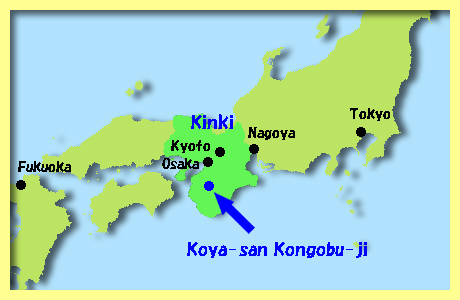
In A.D.816, Emperor Saga permitted Kukai ( Kobo Daishi ) to found a monastery on Koya-san ( Mount Koya - above ), which is located in the north of Wakayama Prefecture. Kukai was a famous priest who established
Japanese Shingon Buddhism. So he founded Koya-san Kongobu-ji as the head temple of his Buddhism sect.
Since then on Koya-san Kongobu-ji has grown to be one of the largest temple complexes. There had been a few thousands of temples in the precinct, where remain more than 100 temples. There are many structures including National Treasures and Important Cultural Properties of Japan. Some areas of its precinct are parts of UNESCO World Heritage Site "Sacred Sites and Pilgrimage Routes in the Kii Mountain Range" as well as Kumano Sanzan are.
Since the foundation so many people, including emperors, ex-emperors, aristocrats, monks, priests, warlords, feudal lords and common people, visited Koya-san Kongobu-ji Temple. Now so do lots of tourists and pilgrims, especially those who complete Shikoku Henro Pilgrimage, which is deeply related to Kukai ( Kobo Daishi ).
|
|
Konpon Daito Pagoda

Konpon Daito Pagoda ( 38 meters tall - above ) enshrines Dainichi Nyorai ( Cosmic Buddha or Variocana ) surrounded by a few dozens of Buddhist statues and paintings, the whole of which represents three dimensional mandala. The Pagoda is the most important training centre of Koya-san Shingon Buddhism.
Konpon Daito Pagoda is located in Danjo Garan area, which is one of the most sacred areas in the precinct of Koya-san Kongobu-ji Temple. In the 9th century, the Temple was founded in Danjo Garan area, where are more than a dozen of important structures as well as Konpon Daito Pagoda is.
|
|
Kon-do Hall

Kon-do ( 24 meters tall - above ) is located next to Konpon Daito Pagoda in Danjo Garan area. Most of the important rituals have been and are held for the whole of Koya-san Kongobu-ji Temple in Kon-do as the main and central hall.
|
|
Fudo-do

The 1st structure of Fudo-do was built at the request of Hachijo Nyoin, an imperial princess in a style of the residence of courtiers in A.D.1198. The current building of Fudo-do ( above ) was reconstructed in the early 14th century and is the oldest among the buildings located in Danjo Garan area while it is the 2nd oldest among the structures in the whole of Koya-san Kongobu-ji Temple. Fudo-do is one of National Treasures of Japan.
Fudo-do had enshrined the statue of Fudo Myo-o ( Acala ) accompanied by the statues of the eight attendants, which are designated as Important Cultural Properties and Natuional Treasures of Japan. So they are now housed in Reihokan Museum, which is located in the site of Koya-san Kongobu-ji Temple.
|
|
Mie-do Portrait Hall
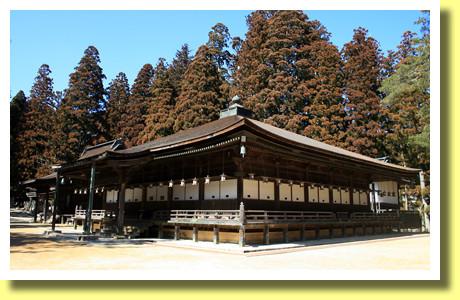
Mie-do Portrait Hall enshrines a portrait of Kukai ( Kobo Daishi ), the founder of Koya-san Kongobu-ji Temple, painted by one of his disciples. Also Mie-do houses portraits of ten of his disciples. The current building of Mie-do was reconstructed in A.D.1847.
|
|
Sanno-in Shrine
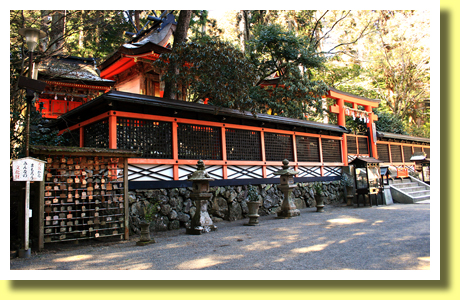
Though Koya-san Kongobu-ji Temple is a Buddhism Temple Complex, there is Sanno-in ( above ), a Shinto shrine in the precinct. Sanno-in Shrine was founded in A.D.819 to worship the god of Koya-san ( Mount Koya ). The current structures of the shrine were reconstructed in A.D.1845 and are Important Cultural Properties of Japan.
|
|
Jabara-michi path

While tourists could enjoy viewing autumn colours here and there in Koya-san Kongobu-ji Temple, Jabara-michi path ( above ) could be the most briliiant autumn foliage spot in the precinct.
|
|
Kongobu-ji Temple
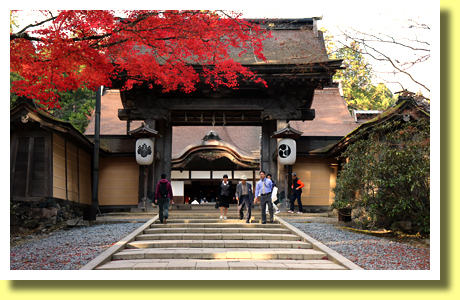
" Koya-san Kongobu-ji Temple " is a Buddhism complex including more than 100 temples, among which the head temple ( above ) is also called the same. It was founded as Seigan-ji Temple in A.D.1593 by Hideyoshi Toyotomi who constructed Osaka-jo Castle in A.D.1585 and unified Japan in A.D.1590. The current structure of the temple was rebuilt in A.D.1863. In A.D.1869 the temple was renamed " Koya-san Kongobu-ji ".
In the temple tourists could see many fusuma ( sliding doors ) painted in the 16th - 17th century by famous artists such as Motonobu Kano, Tanyu Kano, Tansai Yamamoto and so on. Also Banryutei Rock Garden is popular among tourists. In the garden more than 100 rocks are arranged to represent a pair of dragons. The kitchen in the temple is interesting. It is large enough to prepare food for a few thousands of monks.
|
|
Approach to Oku-no-in

Some people walk 2km approach to Oku-no-in Mausoleum from Ichi-no-hashi Bridge. The approach ( above ) is lined with hundreds of cedar trees and more than 200,000 tombstones ( memorial towers ) including those of famous warlords such as Nobunaga Oda, Hideyoshi Toyotomi, Shingen Takeda, Kenshin Uesugi and so on.
While the above is the traditional approach to Oku-no-in, many tourists start walking shorter approach to Oku-no-in Mausoleum from Oku-no-in Mae bus stop. It is lined with modern memorial towers.
|
|
Oku-no-in Mausoleum

Oku-no-in Mausoleum, the most sacred site in the precinct of Koya-san Kongobu-ji Temple Complex, is beyond the Gobyo-bashi Bridge ( above ). Before crossing the bridge, people bow to Kukai ( Kobo Daishi ) who founded the temple. They believe that Kukai has been meditating in the mausoleum since A.D.835. It is prohibited to take pictures beyond the Gobyo-bashi Bridge.
There in front of the mausoleum is Toro-do ( Lantern Hall ), which houses a dozen of thousands of lanterns dedicated by Emperors, Royal Family, monks, courtiers and ordinary people. Some of lanterns have remained lit for a thousand years.
|
|
Tokugawa Mausoleum

In Tokugawa Mausoleum remain two structures - one for Ieyasu Tokgawa, who established Tokugawa Shogunate in A.D.1603 in Tokyo and the other one for his son, Hidetada Tokugawa. Both structures were constructed in A.D.1643 by Iemitsu Tokugawa, a son of Hidetada, who also constructed Nikko Toshogu Shrine and are Important Cultural Properties of Japan.
|
|
Dai-mon Gate
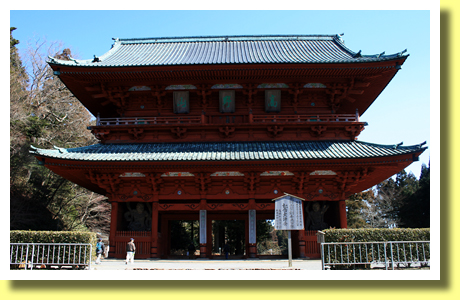
Dai-mon Gate ( 25 meters tall - above ), the main entrance to the precinct of Koya-san Kongobu-ji Temple, was reconstructed in A.D.1705 and is one of the Important Cultural Properties of Japan. The Gate houses a pair of the statues of Kongo Rikishi ( Guardian Deities ) guard the precinct.
|
|
Nyonin-do ( Women's Temple )
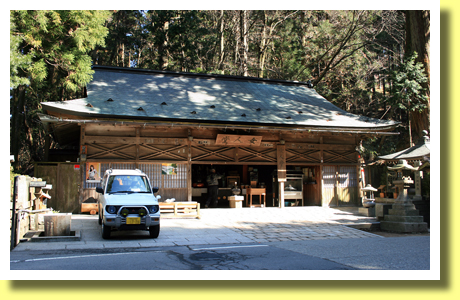
Outside the precinct, there had been seven Nyonin-do ( Women's Temples - above). While women had not been allowed to enter the precinct, Nyonin-do ( Women's Temples ) were built as prayer sites for them near the entrances. It was in A.D.1872 that the ban was lifted. Now only one Nyonin-do among seven remains near Fudo-saka Entrance.
|
|
Kongo-sanmai-in Temple
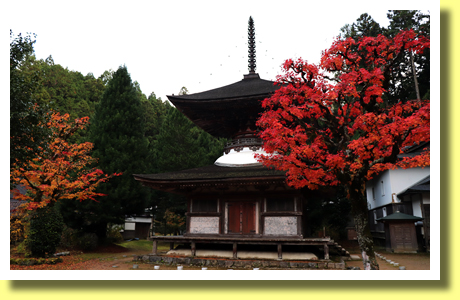
Kongo-sanmai-in is one of more than 100 temples located in the precinct of Koya-san Kongobu-ji Temple Complex and is famous for its Tahoto ( two-storied pagoda - above ), which was constructed in A.D.1223 and is one of National Treasures of Japan. Kongo-sanmai-in was founded in A.D.1211 by Masako Hojo, wife of Yoritomo Minamoto who established Kamakura Shogunate in Kamakura.
|
|
Shukubo ( Temple Guesthouse )
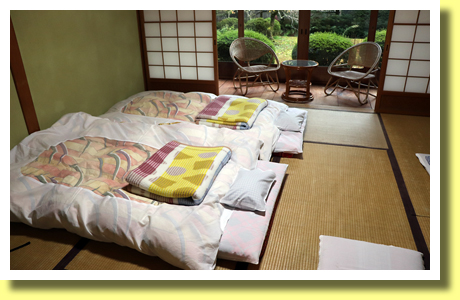
Kongo-sanmai-in Temple is one of more than 50 shukubo ( temples offering accommodations not only to pilgrims but also to tourists ) in Koya-san. Most of shukubo offer traditional Japanese rooms with futon bedding, fusuma ( sliding doors ) and tatami ( floors ). The above shows a room offered in Kongo-sanmai-in Temple.
|
|
Shojin Ryori ( Buddhist vegetarian cuisine )
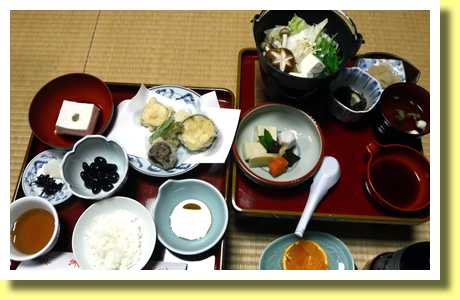
The above shows Shojin Ryori ( Buddhist vegetarian cuisine ) served in Kongo-sanmai-in Temple, including which most of shukubo temples would serve Shojin Ryori to guests. Shojin Ryori includes various kinds of dishes in which various kinds of ingredients are used such as tofu ( soybean curd ), goma-dofu ( sesame seed curd ), shiitake mushroom, seaweed, black soybeans, runner beans, shimeji mushroom, Chinese cabbage, boiled rice and many more.
However no meat nor fish is used in Shojin Ryori, which had developed as Buddhist cuisine since the 13th century while Buddhism had not expected animals to be killed.
So Koya-san Kongobu-ji Temple Complex is one of the most popular Buddhism temple complexes in Japan as well as Hiei-zan Enryaku-ji Temple is.
|
Copyright (c) 2022 Achi-Kochi Zanmai Co., Ltd.
|